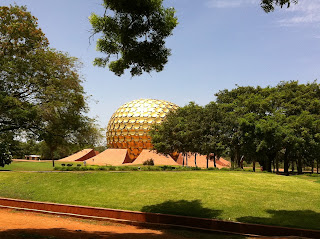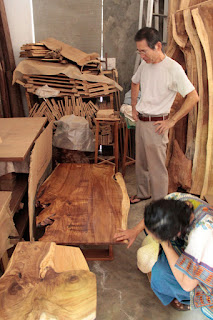 |
| D. Venkatapathy |
Upon the recommendation of friend and colleague, Virginia Jardim, while in India I visited a community of painters and sculptors who were at the forefront of the Indian Modernist Movement in the 1950's-80's. They live together just 25 minutes south of Chennai in a place called Cholamandal Artist Village. I arrived at their museum with a friend via a hired car, and was greeted by the manager, S.Nandagopal. Since we had exchanged emails before my visit, he was so kind as to insist on refunding our tickets (R20 each) and give us a guide who introduced us to four resident artists.
This is D. Venkatapathy, a painter whose shock of while hair only serves to underscore his intensity. He told me about the beginning of the artist village, how they built everything from scratch with the help of some government funding and visiting artists and architects from India, Europe and North America.
Then I walked down the dirt street to a house with a large outdoor workshop full of half-hewn bodies in stone. Here, I chatted with Nupur Chatterjee and Rajasekaran Nair in their home studio, a cool, cozy brick abode that feels somewhat medieval with the brick cobwebs encircling their cast iron and granite sculptures adorning every nook and cranny.
 |


Nupur Chatterjee works with metal. Her work is small, taking inspiration from forest floors strewn with mushrooms, tree sprouts, and leaves. (She also has a fondness for drawing cats, and unfortunately I don't have a picture of them here.) She studied at the Shantiniketan Campus of Viswa-Bharati University, founded by Nobel laureate Rabindranath Tagore. She came to Chennai after graduation, upon hearing about what the artists were trying to establish here and has been here for over 7 years.
Her partner, Rakasekaran Nair, sculpts semi-figurative granite forms that are more monumental and stark in their polished black and rough grey surfaces. "The work is time-consuming and difficult," he tells me. "Granite is the hardest stone." His figures remind me of the soul, sinuous forms breaking free or emerging from the restrictions of stone. Like metaphors for the mind.
This is the self-designed home of the painter P. Gopinath, who was also one of the first artists to settle at Cholamandal Village. Originally from Kerala, he came to study with the founder K.C.S. Paniker (1911-1977), and has since taken a leadership role in the community. His beautiful studio is filled with expansive windows to maximize airflow and light.
His work is saturated by the colors of the earth here (which is often a gorgeous orange) and the spices and surroundings of his native Kerala.
























